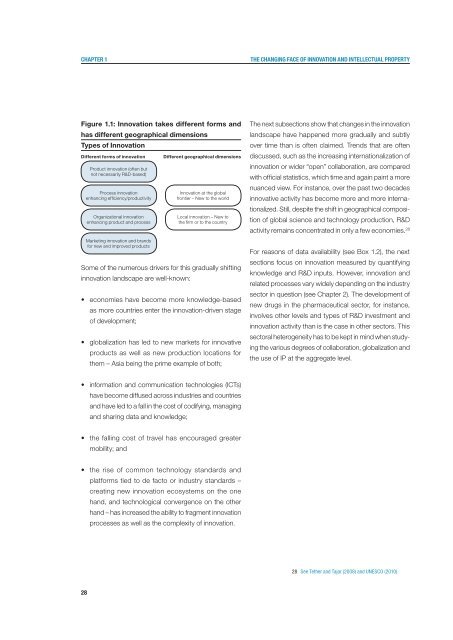World Intellectual Property Report 2011
World Intellectual Property Report 2011
World Intellectual Property Report 2011
You also want an ePaper? Increase the reach of your titles
YUMPU automatically turns print PDFs into web optimized ePapers that Google loves.
Chapter 1 the Changing faCe of innovation and intelleCtual property<br />
Figure 1.1: Innovation takes different forms and<br />
has different geographical dimensions<br />
Types of Innovation<br />
Different forms of innovation Different geographical dimensions<br />
Some of the numerous drivers for this gradually shifting<br />
innovation landscape are well-known:<br />
• economies have become more knowledge-based<br />
as more countries enter the innovation-driven stage<br />
of development;<br />
• globalization has led to new markets for innovative<br />
products as well as new production locations for<br />
them – Asia being the prime example of both;<br />
• information and communication technologies (ICTs)<br />
have become diffused across industries and countries<br />
and have led to a fall in the cost of codifying, managing<br />
and sharing data and knowledge;<br />
• the falling cost of travel has encouraged greater<br />
mobility; and<br />
• the rise of common technology standards and<br />
platforms tied to de facto or industry standards –<br />
creating new innovation ecosystems on the one<br />
hand, and technological convergence on the other<br />
hand – has increased the ability to fragment innovation<br />
processes as well as the complexity of innovation.<br />
28<br />
Product innovation (often but<br />
not necessarily R&D-based)<br />
Process innovation<br />
enhancing efficiency/productivity<br />
Organizational innovation<br />
enhancing product and process<br />
Marketing innovation and brands<br />
for new and improved products<br />
Innovation at the global<br />
frontier – New to the world<br />
Local innovation – New to<br />
the firm or to the country<br />
The next subsections show that changes in the innovation<br />
landscape have happened more gradually and subtly<br />
over time than is often claimed. Trends that are often<br />
discussed, such as the increasing internationalization of<br />
innovation or wider “open” collaboration, are compared<br />
with official statistics, which time and again paint a more<br />
nuanced view. For instance, over the past two decades<br />
innovative activity has become more and more internationalized.<br />
Still, despite the shift in geographical composition<br />
of global science and technology production, R&D<br />
activity remains concentrated in only a few economies. 28<br />
For reasons of data availability (see Box 1.2), the next<br />
sections focus on innovation measured by quantifying<br />
knowledge and R&D inputs. However, innovation and<br />
related processes vary widely depending on the industry<br />
sector in question (see Chapter 2). The development of<br />
new drugs in the pharmaceutical sector, for instance,<br />
involves other levels and types of R&D investment and<br />
innovation activity than is the case in other sectors. This<br />
sectoral heterogeneity has to be kept in mind when studying<br />
the various degrees of collaboration, globalization and<br />
the use of IP at the aggregate level.<br />
28 See Tether and Tajar (2008) and UNESCO (2010).

















